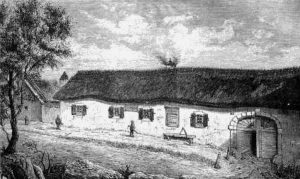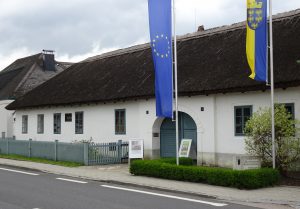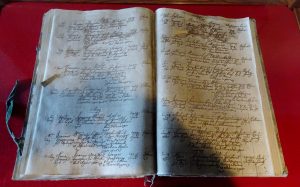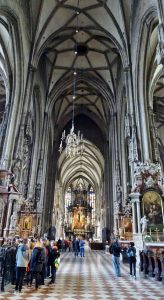The Schumann Quartet are bringing Haydn’s Op. 1 No. 1 to their Music TORONTO concert, Feb 27, 2020.
Is this Op. 1 No. 1 Haydn’s very first published work?
The first string quartet from the man known as the ‘Father’ of the string quartet?
. . . . . . Would that it was so simple!
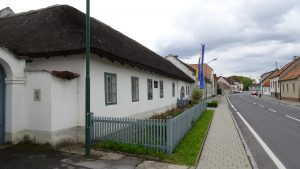
Haydn’s birthplace today. The building suffered flooding and fire. Now rebuilt, it houses a museum and concert room

Rohrau, Haydn’s birthplace , oil painting, 1800 Obere Hauptstrasse 25, likely where Haydn, but not his Op. 1, was conceived
By the time this oil painting was made at the beginning of the 19th century, Haydn was reaching the end of his string quartet-writing days.
The two movements of No. 68 were on his writing desk.
His former pupil and long-time friend, Ignaz Joseph Pleyel, now rivalled his teacher as the most popular composer in Europe.
Pleyel, however, was already phasing out composing in favour of publishing.
One of the earliest of some 4,000 works to come from the Paris-based Maison Pleyel was the first complete edition of Haydn’s string quartets.
That was in 1802.
Pleyel followed the lead of many earlier publishers throughout Europe by referring to the early B-flat quartet as Op. 1 No. 1.

Pleyel’s first edition of his complete Haydn string quartets was published 1802.
This is a variant, published c1803-6,
dedicated to Napoleon Bonaparte, now known as the ‘Bonaparte Edition.’
The St Lawrence SQ keep an eye on it in the library at Stanford University.
Publishing was, of course, a free-for-all in the 18th century.
La Chevadière in Paris had been the first to assemble an Op. 1 collection of six of Haydn’s quartets.
He put it together from manuscript copies circulating in Paris in the mid-1760s.
Haydn didn’t know about it or he might have pointed out that one of the quartets was really one of his symphonies and not a quartet at all.
Two more are sextets for string quartet with two horns.
Score 3 out of 6 for La Chevadière.
Meanwhile, in Amsterdam, Johann Julius Hummel was assembling his own Op. 1 collection, plus a further six-pack of Haydn quartets, which he titled Op. 2.
Like all early publishers, he arranged them in the way he thought would deliver the most sales.
Score 7 out of 6 for Hummel.
That’s because he included an E-flat quartet (Hob.II:6) which became lost, until re-discovered in the 1930s.
Some linear-thinker then catalogued the poor thing as Op. ‘O’, under which handicap it has languished ever since.
So, all in all, Haydn wrote a total of ten early quartets, known for the past 270+ years as Opp. 1 and 2.
He called them cassations, nocturnes, or the term that gets the most nods in academic circles these days, divertimenti a quattro.
However, consider this.
We might not have Haydn’s ten early quartets had the young Haydn undergone a surgical procedure recommended by an unknown official at the Stephansdom, St Stephen’s Cathedral, in Vienna.
Ahem. We need to backtrack.
This is the ground floor bedroom at the Haydn family home, in Rohrau, Lower Austria, which I recently visited.
The reed-thatched building was built by Haydn’s father, Mathias, a wheelwright. He had his workshop at the back, across a small garden.
It is the room where both Joseph and his younger brother Michael were born. [Michael, also a gifted composer, followed in his brother’s footsteps, serving most of his working life at the archiepiscopal court in Salzburg].

Schloss Rohrau today, for over 400 years the property of the Harrach family, a few minutes’ walk from the Haydn Birthplace

A rather sorry-looking Haydn monument in the Rohrau town centre. Count Harrach originally installed it in his palace grounds.
Haydn, however, only lived at Rohrau until he was six.
He was then taken in by a distant cousin named Johann Mathias Franck in Hainburg, his father’s birthplace, some 10 km to the North.
Franck was a schoolteacher and also in charge of the music at a local church.
His teaching and Haydn’s rapid progress drew the young Haydn sometime around 1740 to the attention of Georg Reutter, Kapellmeister at St Stephen’s, the metropolitan cathedral church of Vienna.
Haydn was auditioned and chosen as one of six choristers that year to receive training and boarding at the Stefansdom.
Haydn spent the next decade at the gothic St Stephen’s in a city then at the height of its Baroque splendour.
The young Haydn sang the daily services, learning harpsichord, violin and possibly organ.
He did not receive composition lessons while serving the church.
But he did recall having all of two theory lessons from Reutter!
He also had the dubious privilege of singing many of Reutter’s 500
compositions written for the
church calendar and the needs
of the Habsburg court.
Haydn excelled at what he did and became the leading treble
soloist by his mid-teens.
That’s when the question of surgery was raised, with a view to offering the boy a future as a soloist in a society where a castrato singer would be in high demand.
Mathias Haydn, by now also village Marktrichter, or mayor, heard of it, rushed into Vienna and put a stop to that idea.
At 17, Haydn’s voice broke.
His brother Michael became the main treble soloist.
Haydn was now on his own: a freelance musician in Vienna at the age of 17.
But the musical and personal skills he had acquired were useful and his contacts were developing.
He was both keyboard and string musician, he sang, he taught and, of course, he composed.
Here’s how he would spend a typical Sunday morning:
08:00 Leading the orchestra on violin at the Barmherzige Brüder church on Taborstrasse.
10:00 Playing organ in the private chapel of Count Haugwitz, Wipplingerstrasse.
11:00 Singing with his former choir in the choral service at the Stephansdom.
[We have this information and many more details about Haydn’s early life from the German diplomat George August Griesinger, who interviewed the then famous composer many times towards the end of his life. Griesinger’s seven-part biography appeared in a journal shortly after the composer’s death, in 1809.
The following year, it was edited and expanded into a book].
Two or three years into Haydn’s new life, he had virtually all his possessions stolen while living in a garret behind the Hofburg Imperial palace.
A wealthy government official named Carl Joseph Weber von Fürnberg (1720-67) came to Haydn’s rescue, offering him free accomodation and meals for two months.
No less helpfully, Fürnberg later commissioned the young composer to provide music for an informal gathering of musicians that he liked to host at his country residence, the Schloss Weinzierl, to the west of Vienna.
The group included his estate steward and chaplain, Albrechtsberger (either composer Johann or his cellist brother Anton) and Haydn, playing violin.
Symphonies were sometimes adapted by the quartet – as may well have been the case with the symphony (Hob. I:107), erroneously included in the Op. 1 collection of Haydn’s early quartets published in Paris by La Chevadière.
It was for this informal gathering that Haydn’s early divertimenti a quattro came to be created.
The new medium of two violins, viola and cello provided Haydn with a springboard for music that is immediately entertaining and pleasing.
A Spring music festival has been held at the Schloss Weinzierl since 2009 to mark the location where Haydn’s first string quartets were performed. Read about it HERE
By the time Haydn returned to the medium (c1768-70) with a consciously planned set of six string quartets, published (without his approval) as his Op. 9, he had already served his apprenticeship at the Esterházy court and was well into his duties as Kapellmeister to a family he would serve for the greater part of his future career. [And there’s much more about this chapter of Haydn’s life on the MusicTORONTO blog HERE].
From its modest beginnings at Schloss Weinzierl, Haydn would develop his string quartet catalogue into one of the landmarks of 18th century musical composition.
The Schumann Quartet plays Haydn Op. 1 No. 1, Shostakovich and Smetana, Thursday February 27, 2020
© Copyright 2020 Keith Horner – [email protected]
